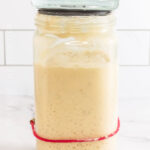Sourdough Starter
Learn how to create a homemade Sourdough Starter with this easy recipe. Perfect for baking delicious, tangy sourdough bread, this guide takes you through simple steps to cultivate a live culture that will elevate your baking. Ideal for both beginners and seasoned bakers.
Equipment
- large jar
Ingredients
- 113 g whole wheat flour - or bread flour, pumpernickel flour (1 cup) - for best results
- 113 g distilled water ½ cup
Instructions
Day One
- In a large plastic or glass container (Ball jar, etc), combine the flour and water. We recommend using room-temperature distilled water to create your starter from the beginning. Once it’s established, you can switch to tap water if desired.
- Cover loosely with an askew lid, coffee filter, or clean dishcloth.
Day Two thru Fourteen
- Remove half of the water/flour mixture from the container. It should be about ½ of a cup or 113 grams worth. Throw it in the trash. DO NOT wash it down the drain - it is like cement and causes plumbing issues! This is called the discard - it can be used in some recipes that call for “sourdough discard”.
- “Feed” the remaining starter in the jar with another 113 grams of flour and 113 grams of distilled water.
- Place a rubber band around the container to mark the growth. It is ready to use once it has at least doubled.
Day 15 and continuing on
- The starter can now be used to bake.
- If it is left at room temperature, continue the discard and feed process at least every other day for a strong, reactive starter.
- If you want to slow it down because you aren’t using it as frequently, you can refrigerate the starter and feed it every couple of weeks. To feed at this rate, remove it from the fridge, feed it, and set it at room temperature for at least a day before baking with it again.
Notes -
- The sourdough starter will have a funky smell for the first few days. This is normal.
- Do not use the starter to bake for about two weeks while it is growing. It will not have the proper rising attributes or taste.
- The starter is ready to be used for baking when you have fed it and it doubles in size within a few hours. It should be bubbly and have that sourdough “tangy” smell.
- Be sure to use clean utensils - any contaminants can kill the starter. This is why we recommend distilled water to create the starter. Once it’s strong and active, you can switch to tap water but watch it for possible issues.
- Flours with a higher protein and gluten content will create a stronger starter. You may use all-purpose flour to feed it and for baking.
- When a recipe calls for an active sourdough starter - this is the starter a few hours after it has been fed, when it is happy and bubbly (not a dormant starter or the discarded starter). When properly maintained, the starter can last for centuries.
Notes
We highly recommend the use of a scale for the most accurate results; however, we’ve included the approximate measurements as well.
Storage: Keep sourdough starter in a clean container. When fed every day or every other day, it can be left on the counter and loosely covered. If fed every couple of weeks, store it in the fridge.
